American Anti-Slavery and Civil Rights Timeline
Timeline compiled by V. Chapman Smith
- 1472
- Portuguese negotiate the first slave trade agreement that also includes gold and ivory. By the end of the 19th Century, because of the slave trade, five times as many Africans (over 11 million) would arrive in the Americas than Europeans.
- 1503
- Spanish and Portuguese bring African slaves to the Caribbean and Central America to replace Native Americans in the gold mines.
- 1610
- Henry Hudson's ship, the Half Moon arrives in the "New World" mostly likely carrying African slaves. The Dutch were deeply involved in the African slave trade and brought the trade to the American colonies. The Dutch built and grew wealthy on an Atlantic empire of sugar, slaves, and ships.
- 1619
- A Dutch ship brings the first permanent African settlers to Jamestown, VA.
- 1641
- Massachusetts becomes the first colony to recognize slavery as a legal institution in 1641 Body of Liberties.
- 1651
- Rhode Island declares an enslaved person must be freed after 10 years of service.
- 1663
- A Virginia court decides a child born to an enslaved mother is also a slave.
- 1671
- George Fox, generally called the founder of the Religious Society of Friends (Quakers), influences agitation among Quakers against slaveholding by Society members when he speaks against slavery on his visit to North America.
- 1672
- The King of England charters the Royal African Company, thereby encouraging the expansion of the British slave trade.
- 1676
- Nathaniel Bacon (Bacon's Rebellion) appeals to enslaved blacks to join in his cause.
- Slavery is prohibited in West New Jersey, a Quaker settlement in current day South New Jersey.
- 1688
- In Germantown (now Philadelphia, PA.), Quakers and Mennonites protest against slavery. During this period, these groups worshiped together.
- 1693
- An Exhortation & Caution to Friends Concerning the Buying or Keeping of Negroes by the Philadelphia Monthly Meeting is published in Philadelphia.
- 1730
- From this time onward, England trades aggressively in North American slaves, with New York, Boston and Charleston thriving as homeports for slave vessels.
- 1750
- Georgia is the last of the British North American colonies to legalize slavery.
- 1754
- John Woolman (b. New Jersey 1720; d. York, England 1772) addresses his fellow Quakers in Some Consideration of the Keeping of Negroes and exerts great influence in leading the Society of Friends to recognize the evil of slavery. Philadelphia Yearly Meeting appoints a committee in 1758 to visit those Friends still holding slaves. At the Yearly Meeting in London in 1772, Woolman presents an anti-slavery certificate from Philadelphia. The London Yearly Meeting also issues a statement condemning slavery in its Epistle for the first time in 1754.
- 1759
- Publication in Germantown (PA) of Anthony Benezet's pamphlet, Observations on the Inslaving [sic], Importing and Purchasing of Negroes, the first of many anti-slavery works by the most influential antislavery writer of 18th century America.
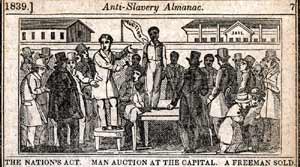
Library Company of Philadelphia
- 1775
- Founding of the Pennsylvania Society for Promoting the Abolition of Slavery (PAS), the world's first antislavery society and the first Quaker anti-slavery society. Benjamin Franklin becomes Honorary President of the Society in 1787.
- Thomas Paine speaks out against slavery and joins the PAS with Benjamin Rush.
- 1780
- Gradual Emancipation Act passed in Pennsylvania.
- 1785
- Publication in London of John Marrant's book, A Narrative of the Lord's Wonderful Dealings with John Marrant, a Black Man, the first autobiography of a free black.
- 1786
- Publication in London of An Essay on the Slavery and Commerce of the Human Species, Particularly the African, by Thomas Clarkson. Quickly reprinted in the United States, it is the single most influential antislavery work of the late 18th century.
- 1787
- Northwest Ordinance bans slavery in the newly organized territory ceded by Virginia.
- Founding in London of the Society for Effecting the Abolition of the Slave Trade.
- Philadelphia free blacks establish the Free African Society in Philadelphia, the first independent black organization and a mutual aid society.
- The ratified U.S. Constitution allows a male slave to count as three-fifths of a man in determining representation in the House of Representatives. The Constitution sets 1808 as the earliest date for the national government to ban the slave trade.
- Rhode Island outlaws the slave trade.
- William Wilberforce becomes the Parliamentary leader and begins a ten-year campaign to abolish Britain's slave trade.
- 1788
- Pennsylvania amends law to forbid removal of blacks from the state.
- 1791
- First American edition of The Interesting Narrative of the Life of Olaudah Equiano, an eye-witness account of the Middle Passage and the first autobiography by an enslaved African, is published in London in 1789.
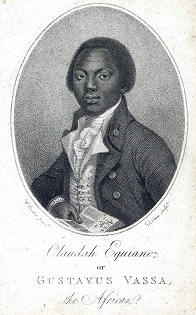
- Slave insurrection in the French colony of St. Domingue begins the bloody process of founding the nation of Haiti, the first independent black country in the Americas. Refugees flee to America, many coming to Philadelphia, the largest and most cosmopolitan city in America with the largest northern free black community. Philadelphia has many supporters for Toussaint L'Overture.
- Eli Whitney patents the cotton gin, making it possible for the expansion of slavery in the South.
- 1793
- U.S. Congress enacts first fugitive slave law requiring the return of fugitives.
- Hoping to build sympathy for their citizenship rights, Philadelphia free blacks rally to minister to the sick and maintain order during the yellow fever epidemic. Many blacks fall victim to the disease.
- 1794
- Founding of the American Convention for Promoting the Abolition of Slavery, a joining several state and regional antislavery societies into a national organization to promote abolition. Conference held in Philadelphia.
- The first independent black churches in America (St. Thomas African Episcopal Church and Bethel Church) established in Philadelphia by Absalom Jones and Richard Allen, respectively, as an act of self-determination and a protest against segregation.
- Congress enacts the federal Slave Trade Act of 1794 prohibiting American vessels to transport slaves to any foreign country from outfitting in American ports.
- 1797
- In the first black initiated petition to Congress, Philadelphia free blacks protest North Carolina laws re-enslaving blacks freed during the Revolution.
- 1799
- A Frenchman residing in Philadelphia is brought before the Mayor, Chief Justice of Federal Court and the Secretary of State for acquiring 130 French uniforms to send to Toussaint L'Overture.
- 1800
- Absalom Jones and other Philadelphia blacks petition Congress against the slave trade and against the fugitive slave act of 1793.
- Gabriel, an enslaved Virginia black, attempts to organize a massive slave insurrection.
- Off the coast of Cuba, the U.S. naval vessel Ganges captures two American vessels, carrying 134 enslaved Africans, for violating the 1794 Slave Trade Act and brings them to Philadelphia for adjudication in federal court by Judge Richard Peters. Peters turns the custody of the Africans over to the Pennsylvania Abolition Society, which attempts to assimilate the Africans into Pennsylvania using the indenture system with many local Quakers serving as sponsors.
- 1803
- Benjamin Rush elected president of the Pennsylvania Abolition Society
- 1804
- Final defeat of the French in St. Domingue results in the founding of Haiti as an independent black nation, and an inspiration to blacks in America. Haitian Independence Day is celebrated throughout northern free black communities.
- 1807
- Parliament outlaws British participation in the African Slave Trade.
- 1808
- United States outlaws American participation in the African Slave Trade. January 1st becomes an instant black American holiday, commemorated with sermons and celebrations. These sermons are the first distinctive and sizable genre of black writing in America.
- 1813
- Philadelphia black businessman and community leader James Forten publishes his pamphlet, A Series of Letters by a Man of Color, to protest a proposed law requiring the registration of blacks coming into the state.
- 1816
- American Colonization Society is formed to encourage free blacks to settle in Liberia, West Africa.
- Several new independent black denominations are established within the African Methodist Episcopal Church under first bishop Richard Allen.
- 1819
- Federal law passed requiring the inspection of passenger conditions on ships is used by Quakers to monitor conditions in the slave trade at the Baltimore (Maryland) Port. Society of Friends members accompany federal Customs inspectors.
- 1820
- Missouri Compromise allows Missouri to become a slave state, establishes Maine as a free state, and bans slavery in the territory west of Missouri.
- The first organized emigration of U.S. blacks back to Africa from New York to Sierra Leone.
- 1821
- New Jersey Quaker born Benjamin Lundy establishes the first American anti-slavery newspaper, The Genius of Universal Emancipation, in Mt. Pleasant, Ohio. From September 1829 until March 1830, William Lloyd Garrison assists the paper. In 1836-1838 Lundy establishes and another anti-slavery weekly in Philadelphia, The National Enquirer. This paper becomes The Pennsylvania Freeman with John Greenleaf Whittier as one of its later editors.
- 1822
- Denmark Vesey, a free black, organizes an unsuccessful slave uprising in Charleston, SC.
- Segregated public schools for blacks open in Philadelphia.
- 1824
- Liberia, on the west coast of Africa, is established by freed American slaves.
- 1827
- John Russwurm and Samuel Cornish establish the first African American newspaper, Freedom's Journal, in New York. The paper circulates in 11 states, the District of Columbia, Haiti, Europe, and Canada.
- Sarah Mapps Douglass, a black educator and contributor to The Anglo African, an early black paper, establishes a school for black children in Philadelphia. Mapps becomes an important leader in the Female Anti-Slavery Society and is a life-long friend of Angelina and Sarah Grimke. After the Civil War, she becomes a leader in the Pennsylvania Branch of the American Freedman's Aid Commission, which worked to protect and provide services to the former enslaved in the South.
- 1829
- David Walker of Boston publishes his fiery denunciation of slavery and racism, Walker's Appeal in Four Articles. Walker's Appeal, arguably the most radical of all anti-slavery documents, causes a great stir with its call for slaves to revolt against their masters and its protest against colonization.
- 1830
- Virginia legislature launches an intense debate on abolishing slavery.
- In response to Ohio's "Black Laws" restricting African American freedom, blacks migrate north to establish free black colonies in Canada, which becomes an important refuge for fugitive slaves.
- The first National Negro Convention convenes in Philadelphia.
- 1831
- William Lloyd Garrison of Boston begins publishing The Liberator, the most famous anti-slavery newspaper.
- Nat Turner launches a bloody uprising among enslaved Virginians in Southampton County.
- 1832
- Maria Stewart of Boston launches a public career as a speaker and pamphleteer. Stewart is one of the first black American female political activists to establish the tradition of political activism and freedom struggle among black women. She calls upon black women to take up what would become pioneering work as teachers, school founders, and education innovators.
- 1833
- American Antislavery Society, led by William Lloyd Garrison, is organized in Philadelphia. For the next three decades, the Society campaigns that slavery is illegal under natural law, and sees the Constitution "a covenant with hell." Within five years, the organization has more than 1,350 chapters and over 250,000 members.
- 1834
- August 1 becomes another black American and abolitionist holiday when Britain abolishes slavery in its colonies.
- 1835
- Female antislavery societies are organized in Boston and Philadelphia. The Philadelphia Female Anti-Slavery Society was an integrated group of white and black middle class women, led by Lucretia Mott, Harriett Forten Purvis, and Grace Bustill Douglass. The women met in each other's homes. Bustill, Mapps, and Douglass are prominent black Quaker families in the Philadelphia in the 19th Century.
- Abolitionists launch a campaign flooding Congress with antislavery petitions.
- 1836
- The public careers of Angelina and Sarah Grimke, Quaker abolitionists from a prominent South Carolina family, begin.
- 1837
- Philadelphia blacks, under the leadership of well-to-do Robert Purvis, organize the Vigilance Committee to aid and assist fugitive slaves. Purvis' wife, Harriett Forten Purvis, the daughter of successful black businessman James Forten, leads the Female Vigilant Society. By his contemporaries, Robert Purvis is referred to as the "President of the Underground Railroad."
- First gathering of the Antislavery Convention of American Women, an inter-racial association of various female antislavery groups, becomes the first independent women's political organization.
- Founding of the Institute for Colored Youth, which later became Cheyney University, one of the earliest historically black colleges in the United States.
- 1838
- Philadelphia is plagued with anti-black and anti-abolitionist violence, particularly from Philadelphia white workers who feared that they have to compete with freed slaves for jobs. Second meeting of the Antislavery Convention of American Women, gathered in Philadelphia at the newly built Pennsylvania Hall, is attacked by a mob. The mob burns down the hall, as well as sets a shelter for black orphans on fire and damages a black church. Pennsylvania Hall was open only three days when it fell. More than 2,000 people bought "shares" and raised $40,000 to build the Hall. An official report blames abolitionists for the riots, claiming that they incited violence by upsetting the citizens of Philadelphia with their views and for encouraging "race mixing."
- Pennsylvania blacks are disfranchised in the revised state Constitution.
- A Maryland slave named Fred runs away and later becomes Frederick Douglass.
- 1839
- Abolitionists form the Liberty Party to promote political action against slavery.
- Pope Gregory XVI condemned slavery and the slave trade.
- 1840
- American Anti-Slavery Society splits over the issue of the public involvement of women. Dissidents opposed to women having a formal role form the American and Foreign Anti-Slavery Society.
- Aged and venerable abolitionist Thomas Clarkson chairs the World Anti-Slavery Convention in London. American attendees include William Lloyd Garrison, Lucretia Mott, and Elizabeth Cady Stanton. American women are not allowed to sit among the men or serve as delegates. On their return to America the women hold a women's rights convention, which met in Seneca Falls, NY in 1848.
- Martin Delany publishes The Mystery, the first Black-owned newspaper west of the Alleghenies and he later serves as co-editor of the Rochester North Star with Frederick Douglass.
- 1842
- An angry mob of whites in Philadelphia attacks a black temperance parade celebrating West Indian Emancipation Day. A riot ensues with mayhem lasting three days and resulting in numerous injuries to blacks, who are dragged from their homes and beaten and several homes, an abolitionist meeting place, and a church are set afire.
- 1845
- Narrative of the Life of Frederick Douglass, an American Slave is published in Boston, launching the public career of the most notable black American spokesman of the 19th Century.
- 1846
- War with Mexico adds significant western territory to the United States and opens a new arena in the fight to check the spread of slavery.
- 1848
- Free Soil Party is organized to stop the spread of slavery into the Western territories.
- Slavery is abolished in all French territories.
- Women's Rights Convention is held at Seneca Falls.
- 1849
- Harriet Tubman escapes from slavery. She becomes a major conductor on the Underground Railroad, as well as an advocate for Women's Rights.
- 1850
- The Compromise of 1850 includes a controversial Fugitive Slave Law that compels all citizens to help in the recovery of fugitive slaves. Free blacks form more Vigilance Committees throughout the North to watch for slave hunters and alert the black community.
- 1851
- Federal marshals and Maryland slave hunters seek out suspected fugitive slaves in Christiana (Lancaster County), PA. In the ensuing struggle with black and white abolitionists, one of the attackers is killed, another is seriously wounded, and the fugitives all successfully escape. Thirty-six black men and five white men are charged with treason and conspiracy under the federal 1850 Fugitive Slave Law and brought to trial in federal court at Independence Hall in Philadelphia. This trial becomes a cause celebre for American abolitionists. Attorney Thaddeus Stevens defends the accused by pleading self-defense. All the defendants are found innocent in a jury trial.
- 1852
- Congress repeals the Missouri Compromise, opening western territories to slavery and setting the stage for a bloody struggle between pro and anti slavery forces in Kansas Territory (Bleeding Kansas).
- 1854
- Lincoln University (Pennsylvania) is chartered in April 1854 as Ashmun Institute. It becomes a higher education institution providing an education in the arts and sciences for male youth of African descent. During the first one hundred years of its existence, Lincoln graduates approximately 20 percent of the black physicians and more than 10 percent of the black attorneys in the United States. Thurgood Marshall and Langston Hughes are among its esteemed alumni.
- Martin Delany leads 145 participants in the 4-day National Emigration Convention in Cleveland, OH. His arguments appeal to some educated and successful northern freed blacks and are defiantly opposite the position held by Frederick Douglass and others. His views represent increasing frustrations in the black community. Six years later, Delany signs a treaty with Nigeria to allow black American settlement and the development of cotton production using free West African workers. However this project never develops. During the Civil War, Delany works with others to recruit blacks for the 54th Massachusetts and other units. In 1865 Major Delany becomes the first black commissioned as a line field officer in the U.S. Army.
- 1855
- With the assistance of others, William Still, a leader in the Philadelphia Underground Railroad, and his white colleague Passmore Williamson, intercept slave owner John Weaver, his slave Jane Johnson and her two sons as they are leaving town. The two help Jane and her children leave their master for freedom. Williamson is incarcerated for several months for not bringing Jane Johnson to court. The case becomes a national news story, continuing from August through November.
- 1856
- The Republican Party, newly formed from various groups opposing the extension of slavery, holds its first convention in Philadelphia.
- Wilberforce University, named for English statesman and abolitionist William Wilberforce, opens in Ohio as a private, coeducational institution affiliated with The African Methodist Episcopal Church. This is the first institution of higher education owned and operated by African Americans.
- 1857
- The Supreme Court's Dred Scott decision declares blacks, free or slave, have no citizenship rights.
- 1859
- John Brown conducts a raid at Harper's Ferry, Virginia to free and arm slaves. His effort fails and he is executed.
- 1861
- Lincoln's election in 1860 leads to Southern states seceding and starts Civil War between the free and the slave states. The Secretary of the Navy authorizes enlistment of contrabands (slaves) taken in Confederate territories.
- 1862
- First black Union Army forces are organized in South Carolina.
- Charlotte Forten, daughter of Robert Forten and Robert Purvis' niece, heads to Port Royal, South Carolina as teacher for the Philadelphia Port Royal Commission for the "freed" slaves now in Union controlled territory. The Atlantic Monthly publishes her essays on her experiences, "Life on the Sea Islands," in 1864.
- 1863
- Lincoln issues the Emancipation Proclamation abolishing slavery in territory controlled by the Confederate States of America. The Presidential Order also authorizes the mustering of black men as federal regiments.
- The 54th Massachusetts is organized at Camp Meigs, Readville, Massachusetts. Free blacks from throughout the North enlist in the 54th. Other training stations, like Camp William Penn, outside of Philadelphia in Cheltenham are established for training black troops. Between 178,000 and 200,000 black enlisted men and white officers serve under the Bureau of Colored Troops.
- 1864
- Congress rules that black soldiers must receive equal pay.
- The National Equal Rights League convenes in Syracuse, New York. Delegates are all prominent northern blacks, led by John Mercer Langston who later organized Howard University's Law Department, and included Frederick Douglass and Octavius V. Catto. Working through state chapters, the League promotes an aggressive advocacy agenda to obtain civil rights for blacks. Pennsylvania, New York, Ohio, Illinois, Indiana and Michigan are charged to take the lead. Philadelphia blacks, led by Catto, boycott to desegregate public transportation.
- 1865
- The Civil War ends with a northern victory.
- With their freedom, Southern blacks seek to reunite their families torn apart by slavery, as well as acquire education (particularly reading and writing). Many leave the South for the West and North.
- President Lincoln speaks publicly about extending the franchise to black men, particularly "on the very intelligent, and on those who serve our cause as soldiers."
- Lincoln is assassinated by John Wilkes Booth.
- Andrew Johnson becomes President and begins to implement his own Reconstruction Plan that does not require the franchise for black men in the former Confederate states.
- Many northern states reject referendums to grant black men in their states the franchise.
- Mississippi becomes the first of the former Confederate states to enact laws (Black Codes) severely limiting the rights and liberties of blacks. Other Southern states follow with similar legislation.
- Thirteenth Amendment to the Constitution abolishing slavery is ratified.
- The Freedmen's Bureau is established in the War Department. The Bureau supervises all relief and educational activities relating to refugees and freedmen, including issuing rations, clothing and medicine. The Bureau also assumes custody of confiscated lands or property in the former Confederate States, border states, District of Columbia, and Indian Territory.
- The Ku Klux Klan is formed by ex-Confederates in Pulaski, Tennessee.
- 1866
- Republicans efforts begin to extend suffrage in the District of Columbia. Initial attempts fail with President Johnson's vetoes. Suffrage is finally granted in 1867.
- Congress passes the first civil rights act. President Johnson's veto of the bill is overturned by a two-thirds majority in both houses of Congress, and the bill becomes law. Johnson's attitude contributes to the growth of the Radical Republican movement. These Republicans favor increased intervention in the South and more aid to former slaves, and ultimately to Johnson's impeachment.
- Republicans gain veto-proof majorities in both the Senate and the House.
- In Nashville, Tennessee, Fisk University is established for former slaves by the American Missionary Association. The school becomes the first black American college to receive a class "A" rating by the Southern Association of Colleges and Secondary Schools in 1878. W.E. B. DuBois graduates from Fisk in 1888.
- 1867
- The first election in the District of Columbia to include black voters results in a victory for the Republican ticket. Similar results are repeated in other areas of the country, where blacks are granted the franchise. These elections also produce new black political leaders.
- Congress passes bills granting the franchise to black men in the territories of Nebraska and Colorado, over President Johnson's veto.
- Congress charters Howard University, named after General Oliver O. Howard, Commissioner of the Freeman Bureau and the college's first president. The school's early funding comes from the Freedmen's Bureau. From its outset, it was nonsectarian and open to people of both sexes and all races, although it is considered a historically black college. Howard becomes a premier education institution in the black community and plays an important role in civil rights history. It is here that Thurgood Marshall earns his law degree.
- 1868
- Fourteenth Amendment is ratified making blacks citizens.
- White voters in Iowa pass a referendum granting the franchise to black voters.
- The Klu Klux Klan evolves into a hooded terrorist organization known to its members as "The Invisible Empire of the South." An early influential Klan "Grand Wizard" is Nathan Bedford Forrest, who was a Confederate general during the Civil War.
- 1869
- The National Convention of Colored Men meets in Washington, D.C., promoting suffrage for all black men and the education of former slaves. Advocacy and for rights continues through the Equal Rights Leagues. The franchise and other privileges are still denied black men in most northern areas.
- Congress approves an amendment to the Reconstruction bill for Mississippi, Texas, and Virginia, requiring those states to ratify the Fifteenth Amendment before being readmitted to Congress.
- New York becomes the first northern state to ratify the Fifteenth Amendment.
- James Lewis, John Willis Menard, and Pinckney B.S. Pinchback, all black men from Louisiana, are elected to Congress and but are never seated.
- 1870
- The 15th Amendment is passed permitting black men the right to vote.
- Joseph H. Rainey of South Carolina is the first black to be seated in the House. In all, twenty-two blacks are elected to Congress during Reconstruction .There were seven lawyers, three ministers, one banker, one publisher, two school teachers, and three college presidents.
- Hampton Normal Agricultural Institute is founded by Samuel Chapman Armstrong and chartered as one of the first colleges for blacks. It is also a pioneer in educating American Indians. Booker T. Washington is among its early graduates.
- Pennsylvania, the home of the oldest and largest northern free black community at the time of the Civil War and a major center for the abolition movement, grants the franchise to black men after thirty-two years of disfranchisement.
- 1871
- National Equal Rights League leader, Octavius V. Catto, is assassinated by a white man attempting to discourage black voting in a key Philadelphia election. Catto's funeral is the largest public funeral in Philadelphia since Lincoln's and his death is mourned in black communities throughout the country.
- 1875
- The last U.S. Congress of the 19th century with bi-racial Senate and House passes the Civil Rights Act of 1875. The law protects all Americans, regardless of race, in their access to public accommodations and facilities such as restaurants, theaters, trains and other public transportation, and grants the right to serve on juries. However, the law is not enforced, and the Supreme Court declares it unconstitutional in 1883.
- 1881
- Blanche K Bruce, Mississippi Republican, ends his term in the U.S. Senate. He is the last black to serve in the Senate until Edward Brooke, Massachusetts Republican, in 1967. With Reconstruction replaced with segregation, voting rights for blacks cease in many areas and greatly curtailed in others.
- Booker T. Washington begins to work at the Tuskegee Institute and builds it into a center of learning and industrial and agricultural training for blacks.
- 1892
- Ida B. Wells Barnett begins her campaign against the lynching of blacks, a common practice by white racists and the Klan to instill fear in the black community. She later writes Southern Horrors: Lynch Law in All Its Phases and becomes a tireless worker for women's suffrage.
- 1895
- W.E.B. DuBois begins his social analysis of the black conditions in Philadelphia. Published in 1899, The Philadelphia Negro becomes a lightening rod for black activism in Philadelphia and other communities around the country.
- 1896
- Supreme Court establishes 'separate but equal' doctrine with Plessy vs. Ferguson. This law enables the expansion of growing segregation or "Jim Crow" practices across America, with many states codifying segregation in state constitutions and local laws and ordinances. By 1910, every state in the former Confederacy fully establishes a system of legalized segregation and disfranchisement. The country largely embraces the notion of white supremacy, which re-enforce the cult of "whiteness" that predated the Civil War. Northern areas also embrace "Jim Crow" practices, some codified in law.
- 1901
- George Henry White (North Carolina Republican), the last black to serve in the House of Representatives in the 19th century, leaves office.
- 1905
- The Niagara Movement, the first significant black organized protest movement of the twentieth century, is launched in Buffalo, NY. It is an attempt by a small yet articulate group of radicals to challenge Booker T. Washington's ideals of accommodation. This militant group was led by W.E.B. DuBois and William M. Trotter.
- 1909
- A bi-racial group of activist establishes the National Association for the Advancement of Colored People (NAACP) in NYC. The founders, Ida Wells-Barnett, W.E. B. Dubois, Henry Moscowitz, Mary White Ovington, Oswald Garrison Villard (a descendant of William Lloyd Garrison) and William English Walling, make a renewed call for the struggle for civil and political liberty. DuBois becomes editor of the organization's publication, Crisis magazine, which presents expos?s on conditions and issues in the black community.
- 1910
- Another bi-racial group of activist establishes the National Urban League to remediate the victimization and deplorable social and economic conditions faced by blacks, who migrated North in hope of better prospects. The organization counsels black migrants from the South, help train black social workers, and works in various other ways to bring educational and employment opportunities to blacks. Its research into the problems blacks faced in employment opportunities, recreation, housing, health and sanitation, and education spurs the League's quick growth with chapters eventually throughout the county.
- 1914
- Marcus Garvey establishes the Universal Negro Improvement Association, whose motto is 'One God, One Aim, One Destiny'. The UNIA sets up the Negro Factories Corporation (NFC) to help promote economic self-reliance among blacks. Initially in New York City, UNIA branches are opened in other places, including Philadelphia. In 1935 the UNIA headquarters move to London.
- 1915
- The release of D.W. Griffith's film, Birth of a Nation, which glorifies the Klan and demonizes blacks. The film also inflames race tensions and sets off white attacks on black communities in many areas throughout the United States.
- 1919
- The Red Summer. Twenty-six documented race riots occur, where black communities across the country are attacked. Hundreds of blacks are killed and even more are injured in these attacks. There is widespread property damage in black neighborhoods. Whites also use lynching as a means to intimidate blacks. In some communities, like the District of Columbia, blacks stand their ground. In the 1920's, riots in Florida and Tulsa destroy the black communities.
- 1929
- Charles Hamilton Houston, a black graduate of Harvard University Law School, leaves his private law practice to become an associate professor and vice dean of the School of Law at Howard University. In 1932, he becomes dean, a post he holds until 1935. Houston develops an outstanding program in law at Howard, producing many young attorneys who lead the battle to end segregation in public life. Among his students is Thurgood Marshall.
- Oscar DePriest (Illinois Republican) begins term in House of Representatives. He is the last black to serve in the House until the election of William Dawson in 1943.
- 1936
- Thurgood Marshall leaves private law practice and begins work the National Association for the Advancement of Colored People (NAACP). He heads the NAACP's Legal Defense efforts and works tireless to end segregation, including the landmark case Brown v. Board in 1954. In 1967, Marshall becomes the first black appointed to the U.S. Supreme Court.
- 1939
- Billie Holiday records "Strange Fruit"-a haunting song describing lynching. Disturbed by a photograph of a lynching, Abel Meeropol, a Jewish schoolteacher and activist from the Bronx, writes this verse and melody under the pseudonym Lewis Allan. The song increases public recognition of lynching as racist terror. Between 1882 and1968, mobs lynched 4,743 persons in the United States, over 70 percent of them African Americans.
- 1946
- President Truman issues Executive Order 9808, establishing the President's Committee on Civil Rights to propose measures to strengthen and protect the civil rights. Truman appoints to the Committee leading black civil rights activist, Sadie Alexander, the first black women to earn a PhD and an early leader in the Philadelphia Urban League. Its report, To Secure These Rights, led to Truman's orders to end segregation in the U.S. military and federal Civil Service system. Later in the 1960's President Johnson enlarges Truman's efforts with various civil rights and affirmative action laws to address persistent discrimination.
- 1954
- Brown v. Board decision declares segregation in public schools illegal.
- 1955
- The Montgomery Bus Boycott begins on December 5 after Rosa Parks is arrested for refusing to give up her seat to a white man on the bus. This boycott lasts 381 days and ends with the desegregation of the Montgomery, Alabama bus system on December 21, 1956. As a pastor of a Baptist church in Montgomery, Martin Luther King, Jr. leads this black bus boycott and becomes a national hero.
- 1957
- The Southern Christian Leadership Conference establishes and adopts nonviolent mass action as its cornerstone strategy to gain civil rights and opportunities for blacks. Working initially in the South under the leadership of Martin Luther King, by the mid 1960's King enlarges the organization's focus to address racism in the North.
- 1959-1963
- King's Letter from Birmingham Jail inspires a growing national civil rights movement. In Birmingham, the goal is to end the system of segregation completely in every aspect of public life (stores, no separate bathrooms and drinking fountains, etc.) and in job discrimination. This same year, he delivers his I Have a Dream Speech on the Washington Mall, which becomes an enduring symbol of King's legacy and influence.
- In Birmingham, a white man is seen placing a box containing a bomb under the steps of the 16th Street Baptist Church, a black congregation. The explosion kills four black girls attending Sunday school. Twenty-three others people are also injured in the blast.
- 1964
- President Johnson announces the "Great Society" with "abundance and liberty for all", and declares a "War on Poverty." Congress authorizes the Civil Rights Act, the most far-reaching legislation in U.S. history to ensure the right to vote, guarantee access to public accommodations, and the withdrawal of federal funds to any program administered in a discriminatory way.
- Beginning this year, growing frustrations in black communities over urban decay and lack of opportunities erupts into a wave of race riots through U.S. cities, including Los Angeles, Newark (NJ) and Detroit Michigan. The years 1964 to 1971 see more than 750 riots, killing 228 people and injuring 12,741 others. Additionally, more than 15,000 separate incidents of arson leave many black urban neighborhoods in ruins.
- 1965
- Voting Rights Act is passed, authorizing direct federal intervention to enable blacks to vote.
- Malcolm X is assassinated by members of the Nation of Islam (Black Muslims) in New York City.
- 1967
- Robert C. Weaver is appointed Secretary of Housing and Urban Development. He is the first black to hold a Cabinet position in U.S. history.
- Edward Brooke (Massachusetts Republican) becomes the first black to serve in the Senate since Reconstruction.
- 1968
- On April 4, 1968, James Earl Ray assassinates Martin Luther King, while he is standing on the balcony of the Lorraine Motel in Memphis, Tennessee. In outrage of the murder, many blacks take to the streets in a massive wave of riots across the U.S.
- Congress authorizes the 1968 Civil Rights Act, providing federal enforcement provisions for discrimination in housing. The 1968 expanded on previous acts and prohibited discrimination concerning the sale, rental, and financing of housing based on race, religion, national origin, sex, (and as amended) handicap and family status. This law enabled housing opportunities for blacks beyond the "ghetto."
- 2008
- On November 4, 2008, Barack Obama is elected President of the United States of America.

Library Company of Philadelphia
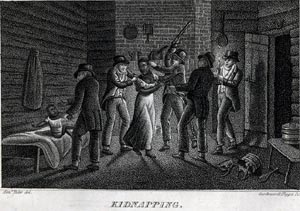
Library Company of Philadelphia
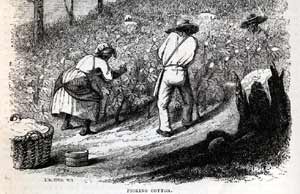
Library Company of Philadelphia
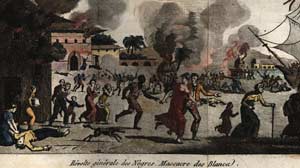
Library Company of Philadelphia
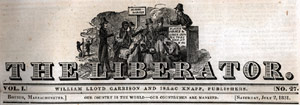
Library Company of Philadelphia
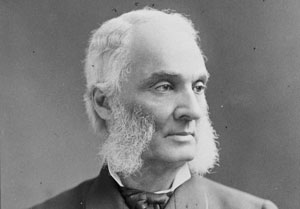
Society Portrait Collection, Gratz Collection, HSP
Portrait of Robert Purvis by Gutekunst Studio, n.d.
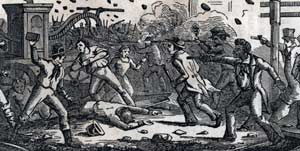
Library Company of Philadelphia
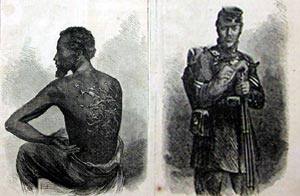
Library Company of Philadelphia
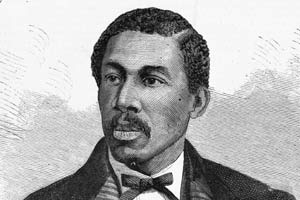
Catto
Library Company of Philadelphia
Portrait of Octavius V. Catto, Harpers Weekly 1871
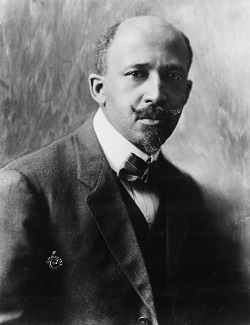
1918 Photo of W.E.B DuBois
LOC id: cph.3a53178

This low-resolution rendering of a copyright protected image for editorial purposes is used under Fair Use.
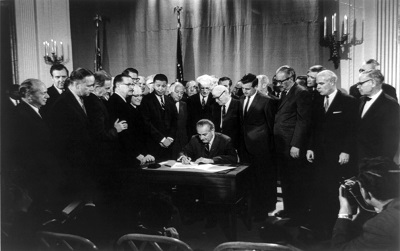
President Lyndon Johnson signing the Civil Rights Act
Photo by U.S. News and World Report
released to Public Domain
This timeline was prepared for NHD Philly, the regional National History Day program for Philadelphia, Pennsylvania. It is a collaboration of more than thirty history and community-based organizations in the Greater Philadelphia region. The participating partners represent some of the most significant history collections and programs in the United States, as well as the region's extensive community of education and heritage tourism enterprises. In addition to the regional National History Day Competition, the collaboration provides programs and products that support not only learning history, but also the development of research and analytical skills through the exploration of special collections, archives, museums and historic sites.


